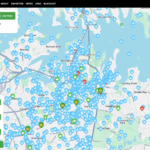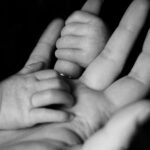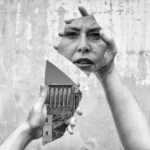Christina Coleman started menstruating at age 11. Painful periods and bleeding through her school uniform became so commonplace the deputy principal often drove her home at the request of her parents.
It took years of intense pain and a medical science degree before Veronica realised she suffered from polycystic ovarian syndrome (PCOS), and that she was experiencing the same symptoms she was learning about at university.
On the brink of 50, and after being dismissed by countless medical professionals, Penny Redmond was diagnosed with adenomyosis – what she calls the “evil cousin” of endometriosis. At the request of her surgeon, Redmond handed a brochure to her GP for them to learn more about this “little-known condition”.
According to the Australian Bureau of Statistics, women are living longer, outlasting men on average by 4.2 years, are more likely to complete undergraduate or postgraduate tertiary education and, as of February, 60.9 per cent were in work compared to 39.5 per cent in 1978.
Yet, while statistics show women generally to have more fulfilling lives, according to the ABS the average number of years lost to disability has increased, and for many women menstruation has led to serious disease burdening their health.
For Christina Coleman, a project officer at The George Institute for Global Health and who is studying a masters of neuroscience, her biggest burden is lost time.
“I have things to do. I have entered a really great time in my life and my career… I do not have time for all of these appointments,” she says. “And yet, every month I am slowed down, for at least a day, by an organ that causes pain that I do not want or need anymore.”
Coleman has endured PCOS, a ruptured ovarian cyst, recurring prolapses due to childbirth, uterine fibroids and perimenopausal symptoms across four decades.
Sitting in a hospital room, while awaiting two surgical procedures, Redmond says: “I recently closed a business due to ongoing health and energy issues. I was not able to replace this full-time employment without knowing that I had a treatment plan in place to minimise my debilitating and chronic pain.”
For years, she felt dismissed by countless medical professionals who chalked her pain up to menopause that had a “50-50 chance of subsiding with time”. She was later diagnosed with adenomyosis — a disease that caused her to bleed, each month, into the muscles of her uterus.
The gender pain gap
Globally, women spend 25 per cent more of their lives in “poor health” than men. This equates to 75 million years of life lost to disability, adding up to seven days, per woman, per year. Potentially more than 500 days lost over a woman’s lifetime.
In a nationwide survey of young Australian women, more than one-third reported missing school or university due to menstrual symptoms.

Photo: Support the Girls
Experiencing frequent periods — two per month due to PCOS – Veronica says it is not always pain that keeps her away from the classroom.
“If you’re at uni and you need a bathroom suddenly, but you are not guaranteed having one with toilet paper nearby, you would just be freaked out because you need it immediately on hand,” she says.
“I have to find a way home without ruining my clothes. It’s very mentally stressful when it’s so unpredictable.”
Jane Homles, founder, director and CEO of Support the Girls, a charity dedicated to empowering vulnerable, disadvantaged women reports seeing more and more of this.
“When young woman cannot attend school due to not having product, you have to question the system,” she says. “We constantly receive emails from organisations, specifically Indigenous… and rural communities… asking for support with products.”
She says no woman or girl should be forced to compromise her health, education or dignity due to lack of access to menstrual products.
Medical Misogyny
 While the Australian Burden of Disease study reveals reproductive and gynaecological diseases are on the rise, it currently captures the burden of conditions including menopause with the catchall, “other reproductive conditions”. As the most comprehensive disease dataset in Australia, it is not possible to clearly identify the prevalence or severity of frequently under-recognised diseases.
While the Australian Burden of Disease study reveals reproductive and gynaecological diseases are on the rise, it currently captures the burden of conditions including menopause with the catchall, “other reproductive conditions”. As the most comprehensive disease dataset in Australia, it is not possible to clearly identify the prevalence or severity of frequently under-recognised diseases.
This is clear when comparing discrepancies in endometriosis data, which are estimated to affect 10 per cent of reproductive aged women by the World Health Organisation, compared to 1-2 per cent in the Global Burden of Disease study. This eightfold difference means any where from 24-190 million women may suffer from endometriosis worldwide.
For Dr Bevan Brown, Redmond’s surgeon and a gynaecologist, this lack of recognition not only creates barriers to care, but diagnostic delays and suboptimal treatment.
During his GP training, working on-call in women’s health and paediatrics, Dr Brown saw how gynaecological problems were often given lower priority.
“Accident and Emergency Department inboxes were the graveyards of women’s problems,” he says. “Even a child with a splinter in a finger would be seen before a woman with a miscarriage, pelvic pain, or anaemia from flooding periods.”
A contemporary analysis of admitted patients by NSW Ambulance further reveals sex and gender inequities in health and medicine can have life-threatening consequences. This is just one of many datasets revealing the increased research and funding diverted to male-orientated health conditions.
But this was not always the case. Claire Hickey, after approaching her GP while training to be a nun in the 1980’s was referred to specialists for a hysterectomy, a notoriously difficult procedure for women to receive today.
“I was lucky. As far as I can see, it was a lot better then, than it is now,” she says.
Surgery revealed Hickey had endometriosis in both ovaries, which were also removed. She says it was such a great relief, her pain completely subsided.
Period Poverty
With the rising cost of living, groceries, including sanitary products, have steadily increased. Pads and tampons which cost $2 a decade ago, are now priced at $10-15 per pack.

Photo: Free Periods (Amelia Allen)
Plan International estimates the average person who menstruates will spend $10,000 in their lifetime – a cost almost six in 10 Australian women are finding more difficult to pay.
For Redmond, this is just the tip of the iceberg. Seeking timely diagnosis and treatment through the private health system, she has spent over $5,000 this year alone.
That does not account for the costs of private health insurance, pain killers; which taken long-term have often overlooked and understudied gastrointestinal risks, the costs of sick leave or leave-without-pay, coexisting mental and physical burdens and time lost.
“When I was referred to a private female gynaecologist, I was told there would be a six-month wait as only one booking a week was reserved for non-pregnant patients.”
And while Coleman believes in the public system, that too is failing, she claims.
That is why Rochelle Courtenay founded Share the Dignity in 2015. After reading about women having to use wadded toilet paper or newspaper as period products and while working as a personal trainer, she decided to ask all of her clients to bring in a pack of period products for every glass of wine they drank.
Over 500 products later, Share the Dignity was born.

Photo: Share the Dignity
Since then, Share the Dignity has collected and distributed over 4.5 million period products through their biannual Dignity Drive and installed 753 Dignity Vending Machines in domestic violence centres, libraries, charities, homeless hubs and Aboriginal and Torres Strait Islander medical services across the country.
Courtenay’s lobbying axed the tampon tax in 2018, abolishing the $30 million a year GST on feminine hygiene products and has established menstrual health programs in remote First Nations communities that do not have access to clean water, functioning toilets or affordable sanity products.
Still, Courtenay maintains her mission is “to ensure everyone is afforded the dignity in life that so many of us take for granted”.
Holmes says the current reality is that “women resort to improvised solutions or sacrifice other essential needs to manage their periods”.
“This lack of access,” she adds, “not only impacts their physical health but also contributes to feelings of shame, embarrassment, and exclusion, exacerbating existing socio-economic disparities.
“[If] more organisations were to collaborate, we could create a future where no woman or girl in Australia is forced to compromise her health.”
The World Economic Forum’s Closing the Women’s Health Gap reports that investing in women’s health shows a positive return. For every $1 invested, $3 is projected in economic growth, or a one-trillion-dollar economic opportunity globally.
“The question is not whether this wealth of opportunity exists but rather who will take the initiative to seize it and drive change,” says Holmes.
Main image of Penny Redmond by Yasmine Alwakal.




























